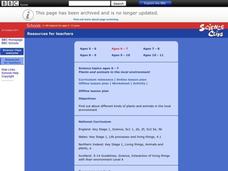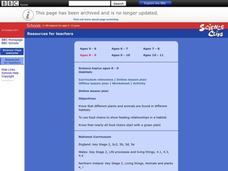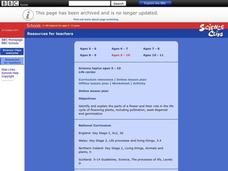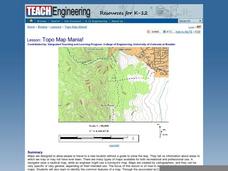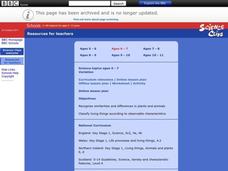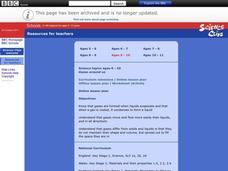Curated OER
Life cycles
Young scholars identify and explain the parts of a flower and their role in the life cycle of flowering plants, including pollination, seed dispersal and germination using the Internet. Students will also study and discuss the key points...
Curated OER
Plants And Animals in the Local Environment
Students observe the various living things they can find outside their playground making sure to look both on the ground and in the air. They develop a large poster Venn digram, as a class, of plants and animals that live in the air, on...
Curated OER
Reversible and irreversible changes
Students define the words "reversible" and "irreversible." They complete a worksheet that shows a number of changes. Students must decide which are reversible and which are irreversible.
Curated OER
Pushes and Pulls
Students discuss and investigate how various vehicles move. In a small groups, students then create a wheeled vehicle and find a way to make it move using various resources provided by the teacher.
Curated OER
Habitats
Learners investigate the habitats of living things and the cycle of the food chain. In this scientific inquiry online lesson, students examine the habitats of plants and animals as well as the food chain as they sort pictures of living...
Curated OER
Solids and Liquids
Students investigate what happens to solids and liquids when they change from one form to another. In this states of matter lesson plan, students work in groups on a virtual experiment that requires them to collect data regarding the...
Curated OER
Moving and Growing
Students learn to understand the role of both skeletons and exoskeletons. In this instructional activity on exoskeletons, students locate and label bones on diagram of a human skeleton, and observe and discuss bones of chicken and fish....
Curated OER
Keeping Warm
Young scholars investigate how different types of objects act as thermal insulators. In this online lesson plan, students hypothesize how particular objects act as insulators and then complete the online activity to determine which...
Curated OER
Growing Plants
Students explore plants and recognize that they are living things that require light and water to grow. In this online plant biology activity, students identify, name and match the parts of plants. Extension activities and suggested...
Curated OER
Pushes and Pulls
Students examine different types of movement and causes that may affect those movements. For this online interactive forces and motion lesson, students use toy cars to observe push and pull and then make predictions and collect data...
Curated OER
Gases Around Us
Students investigate gases and liquids. In this states of matter online lesson, students examine how evaporation plays a part in the transition of liquids into gases as they watch a kettle of water boil and then work in small groups on...
Curated OER
Life Cycles
Students identify and explain the parts of a flower and their role in the life cycle of flowering plants. In this online plant biology lesson, students explore the processes of pollination, seed dispersal, and germination. Extension...
Curated OER
Micro-organisms
Students discuss micro-organisms. For this micro-organisms lesson, students identify which micro-organisms are harmful and which ones are beneficial. Students complete a worksheet which is included in the lesson.
Curated OER
Red Shift, Blue Shift
Middle schoolers demonstrate how stellar spectra measures a star's motion relative to Earth along the line of sight.
Curated OER
Topo Map Mania!
Seventh graders describe the major features of maps and compasses. They read a topographical map. They take a bearing using a compass. They practice using scales on a map.
Curated OER
The Discovery of Ohm's Law
Students study Georg Ohm and how he changed mathematics with his law. In this experimental evidence and stastics lesson students complete an experiment on the characteristics of Ohm's law.
Curated OER
Making Energy "trails"
Students explore ten different stations that demonstrate either chemical, kinetic, or mechanical energy. They examine the way energy is transferred during each station's hands-on activity. Stations include vinegar and baking soda,...
Curated OER
Hot Friction
Sixth graders use small electronic devices known as thermistors to measure the temperature beneath an object such as a coffee cup as it slides across a surface. By choosing different surfaces, 6th graders can compare in a quantitative...
Curated OER
Ohm's Law, Watt's Law and Solving Formulas.
Young scholars, in groups, connect a 10 ohm resistor across their 1.5 volt battery, and take voltage readings every 5 minutes.
Curated OER
Ourselves
Students use a website to name and compare external body parts of humans and other animals.
Curated OER
Sound and Hearing - Internet Research
Young scholars use a website to help them recognize that sound is generated in a variety of ways and from different sources. They determine that sounds vary in tone and loudness, and learn there are different ways to describe sound.
Curated OER
Moving and Growing
Young scholars know that humans and some other animals have bony skeletons inside their body. They know that other animals have skeletons on the outside of their bodies. They explain the role of both kinds of skeletons.
Curated OER
Variation
Students participate in an online lesson to reinforce the similarities and differences in plants and animals. They classify living things according to observable characteristics.
Curated OER
Gases Around Us
Students participate in an online lesson showing that gases are formed when liquids evaporate and that when a gas is cooled, it condenses to form a liquid, and gases move and flow more easily than liquids, and how gases differ from solids.

